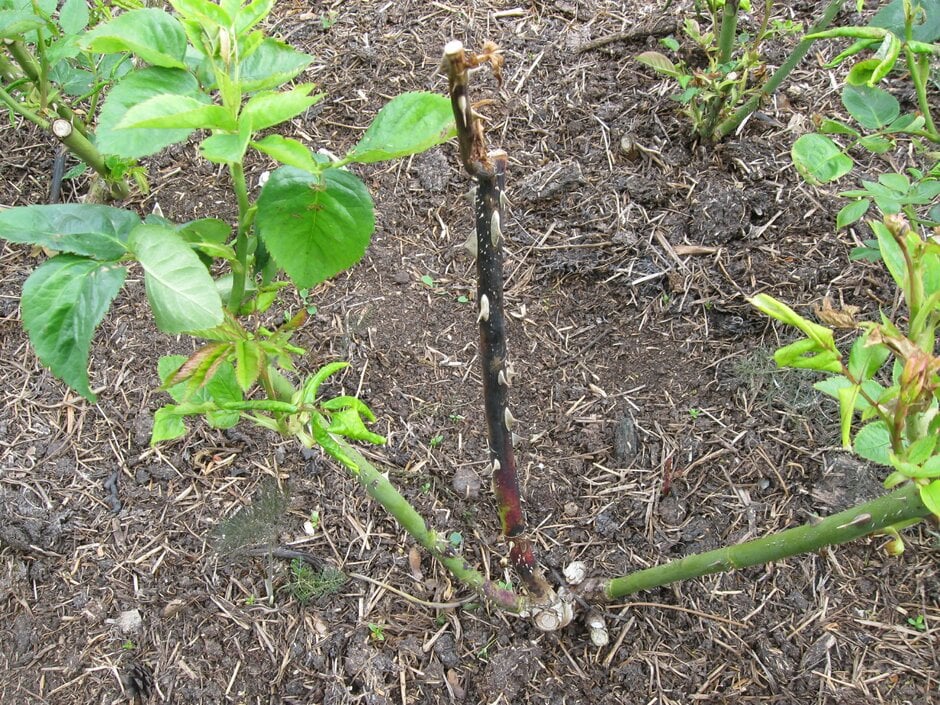Rose dieback
On a rich soil and with good preparation most roses grow away strongly after planting. However, shoot and branch dieback is not an uncommon sight on roses. Weather conditions, poor care and cultivation, diseases or any combination of these can be responsible.

Quick facts
Scientific name None
Plants affected Roses
Main symptoms Browning and dieback of shoot tips, branches or stems. Fungal growth or fruiting bodies are sometimes visible
Caused by Various factors, including adverse weather and soil conditions, poor husbandry and fungal diseases
Timing Dieback may be present at any time of year
What is rose dieback?
Branch or stem dieback of roses is seen to at least some extent in most gardens, but in certain circumstances it can be very widespread and damaging. Any adverse factors that result in stress on the plant and a lack of vigour can lead to dieback.
Canker-causing fungi can invade shoots already affected by dieback, or can colonise the plant through any form of physical damage. Once they have gained entry they can spread into adjacent living tissues to cause further damage.
Symptoms
You may see the following symptoms:
- Browning and dieback of the tips of young shoots in spring (usually the result of frost damage)
- Browning and dieback of a pruning stub, which then progresses further down the branch (the result of a poor pruning technique)
- Dieback of twigs, branches, main stems or even the whole plant at any time of year (various causes)
- Fungal structures, such as tiny black fruiting bodies, are sometimes visible on the affected parts of the plant
- In some instances there may also be associated root decay
Control
Non-chemical control
- Plant roses in well-prepared soil, making sure that the roots are well spread out
- Do not plant roses into soil that has grown roses previously, without taking remedial action. Change the soil to a depth of at least 30cm (1ft) and a width of at least 60cm (2ft). The use of a mycorrhizal additive at planting can also be considered, although these products are still undergoing experimental evaluation into their effectiveness
- Avoid soils that are prone to either drought or waterlogging
- Feed plants in spring with a proprietary rose fertiliser and mulch the soil to prevent water loss
- Remove all dead and damaged wood as soon as it is seen. Also remove weak and crossing branches during routine pruning
- Pruning cuts should be finished cleanly, and made immediately above and sloping away from an outward facing bud
Chemical control
There are no chemical controls available for the prevention of rose dieback.
Biology
Adverse factors leading to plant stress and dieback include:
- Bad planting technique – avoid planting the rose with the graft union buried below soil level
- Soil conditions that are too wet or dry
- Malnutrition
- Poor pruning technique, particularly where the buds are damaged or long pruning stubs are left above them
- Physical damage, for example that created when crossing branches rub together
- Frost damage
- Severe defoliation by insects
- Severe outbreaks of foliar diseases such as black spot, rust or powdery mildew
- Root disease problems, e.g. honey fungus or Phytophthora root rot
- Replant disease, resulting from planting new roses directly into soil that has previously grown roses
Shoots, branches and stems suffering from physical damage, or those already showing dieback due to one or more of the factors listed above, are often invaded by a range of fungi that can cause further damage. Once within the plant these fungi can spread into adjacent healthy tissues, and in severe cases may lead to extensive dieback or even death of the plant.
Two diseases commonly associated with rose dieback are grey mould (Botrytis cinerea) and rose canker (Paraconiothyrium fuckelii, syn. Leptosphaeria coniothyrium). The former, as its name suggests, is sometimes seen as a fuzzy grey mould (particularly on dead flowers and frost-damaged shoots), although this growth may not be present where the fungus has colonised woody tissues.
Paraconiothyrium fuckelii is the most common cause of canker on roses, and can be very destructive. Infection often occurs through bad pruning cuts or injuries to the crown. It produces tiny black fruiting bodies that are sometimes just visible on the bark of affected branches or stems. This fungus also causes cane blight disease of raspberries.
Get involved
The Royal Horticultural Society is the UK’s leading gardening charity. We aim to enrich everyone’s life through plants, and make the UK a greener and more beautiful place.